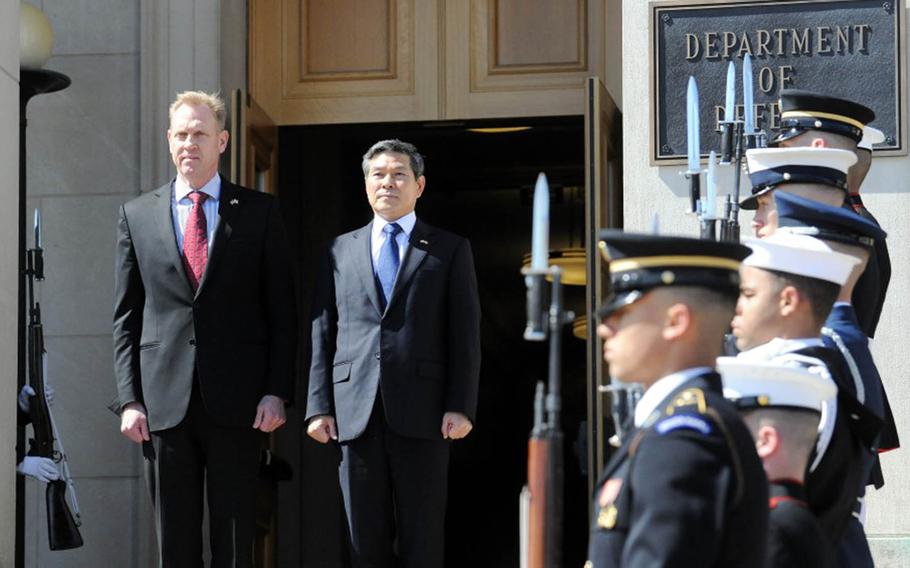
Acting Defense Secretary Pat Shanahan, left, held talks with his South Korean counterpart, Jeong Kyeong-doo, right, in Washington, D.C., Monday, April 1, 2019. (South Korea's Defense Ministry)
SEOUL, South Korea — Joint military exercises conducted by the United States and South Korea last month boosted readiness, the U.S. defense chief said, defending changes aimed at maintaining calm with the North to facilitate nuclear talks.
Acting Defense Secretary Pat Shanahan spoke Monday as he met with his South Korean counterpart in Washington to discuss the recent drills and other alliance issues as efforts to persuade Pyongyang to give up its nuclear weapons have faltered.
Washington and Seoul said early last month that they were ending annual exercises known as Key Resolve and Foal Eagle in favor of lower-profile drills that were renamed Dongmaeng, or Alliance.
Shanahan dismissed concerns that the decision — seen as a concession to the North, which considers the drills a rehearsal for an invasion — would hurt military readiness.
“I don’t think we’re scaling back exercises. I think we’re building capability up,” he said Monday as he welcomed South Korean Defense Minister Jeong Kyeong-doo with an enhanced honor cordon at the Pentagon.
Key Resolve and Foal Eagle featured tens of thousands of U.S. and South Korean troops, including many who came from other countries to practice so-called decapitation plans and other scenarios targeting the North Korean regime.
By contrast, the militaries have not revealed details about the number of participants or details about the computer-simulated drills held in March.
Shanahan and Jeong also stressed that they were working toward the eventual transfer of wartime operational control from the United States to the South Koreans. Currently the Americans would lead joint operations if war broke out.
“As we do operational control and transfer, we want to make sure that there are no gaps or seams, and that we continue to build on these exercises,” Shanahan said. “We’re going to talk about the September exercises and the lessons learned from these ones in March.”
Joint military exercises have long been the lynchpin in the U.S.-South Korean alliance, which was forged in the 1950-53 Korean War that ended in an armistice instead of a peace treaty.
Some 28,500 U.S. troops are stationed on the divided peninsula, principally to guard against a possible invasion from the North.
But President Donald Trump announced that he was suspending the drills, which he said were “very expensive” and “provocative” after his first summit with North Korean leader Kim Jong Un on June 12 in Singapore.
He reiterated that sentiment after the second summit between the two leaders collapsed without agreement on Feb. 28 in Hanoi, Vietnam.
U.S. commanders insist they have been able to adjust by revising the drills.
Gen. Robert Abrams, who commands U.S. Forces Korea as well as the Combined Forces Command and the United Nations Command, was quoted as telling the defense chiefs during a briefing in Washington that Dongmaeng had “strengthened their combined defense and readiness posture and contributed to the groundwork for the transition of wartime operational control.”
Shanahan and Jeong also reaffirmed that the alliance between their two countries is “ironclad” and “ready to face an evolving security environment,” according to a Defense Department readout of their meeting.
“They also pledged to enhance coordination and cooperation in various areas including information sharing pertaining to North Korean issues, such as North Korean nuclear and missile activities,” it said.
gamel.kim@stripes.com Twitter: @kimgamel